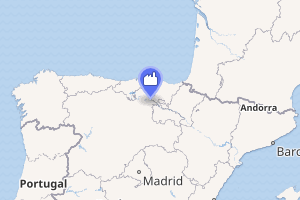Santa María de Garoña Nuclear Power Plant
Santa María de Garoña Nuclear Power Plant is a mothballed nuclear power station at Santa María de Garoña, Burgos (Spain). It consists of one boiling water reactor (BWR) of 466 megawatts (MWe).
| Santa María de Garoña Nuclear Power Plant | |
|---|---|
.jpg) Santa María de Garoña Nuclear Power Plant | |

| |
| Country | Spain |
| Coordinates | 42°46′31.08″N 3°12′26.25″W |
| Status | Mothballed |
| Construction began | September 1, 1966 |
| Commission date | May 11, 1971 |
| Owner(s) |
|
| Operator(s) | Nuclenor S.A. (Iberdrola and Endesa) |
| Nuclear power station | |
| Reactor type | BWR |
| Reactor supplier | General Electric |
| Power generation | |
| Units decommissioned | 1 × 466 MW |
| External links | |
| Commons | Related media on Commons |
The reactor vessel was built in 1966 by the Dutch RDM.,[1] being the oldest Spanish Nuclear Power Plant in service.[2] The reactor is a BWR/3 model with a Mark I containment building.
The plant was opened in 1971 and officially closed on 5 July 2013. Nuclenor, the plant's operator, had sought a ten-year extension, which was supported by Spain's Nuclear Safety Council (Consejo de Seguridad Nuclear, CSN) despite Spain's policy of phasing out nuclear power. On 2 July 2009, the Ministry of Industry, Tourism and Trade compromised, extending the operating license for an additional four years subject to safety upgrades, though this extension was never used.[3][4]
On December 16, 2012, the plant operator Nuclenor has begun shutting down the nuclear power plant, which was due to close in mid-2013, to avoid producing taxable power during 2013. The decision was spurred by an impending law, which would impose a tax in the annual sum of about €150 million. The safety upgrades required for extension of the operation would have cost some €120 million.[5]
In May 2014, following a change in national law allowing mothballed nuclear power stations restart, Nuclenor submitted a request to renew the operating licence, allowing to operate the plant until 2 March 2031.[6]
In July 2014, Nuclenor was fined €18.4 million by the Spanish National Commission on Financial Markets and Competition (CNMC), for having shut down the reactor in December 2012, months before its operational licence was due to expire on 6 July 2013.[6]
In February 2017, Spain's nuclear safety regulator gave conditional approval for the restart and continued operation of the Garoña nuclear power plant, but the operator would be required to make a number of safety upgrades.[7]
However, new concerns on security raised later, in May 2017, as a result of a complaint about the working conditions in a waste store, which was received by the inspection just two days after the approval of the nuclear regulator to the extension of the plant. The waste deposit holds 2,800 radioactive drums that need reprocessing and some of them "have lost integrity and the residue is dispersed inside the silo", according to the CSN. After complaints from staff about exposure to radiation when removing these containers, one of them broke and spread some of its contents on the floor of the plant, as it has been reported.[8]
In August 2017 the Spanish government did not renew its operating licence, and the reactor will be decommissioned.[9]
Garoña vessel inspection
In March 2015 Nuclenor announced that inspections made in November and December 2014 checked the reactor vessel good condition, with no manufacturing defects detected. More than forty GE Hitachi and Tecnatom experts collected data from nine million points on the vessel's surface, for more than 1000 hours and using advanced ultrasound systems and submersible robots.[10]
References
- "shipmotions.nl". www.shipmotions.nl.
- Tracy Rucinski (2012-12-16). "Spain's oldest nuclear plant shuts down". Reuters. Retrieved 2019-02-01.
- "Garoña gets 'irresponsible' and 'arbitrary' life extension". World Nuclear News. 3 July 2009. Retrieved 2009-07-03.
- "Spain Extends Garona Nuclear Plant Operation 4 Yrs". Dow Jones. July 2, 2009. Retrieved 2009-07-03.
- "Garona officially closes". World Nuclear News. 8 July 2013. Retrieved 21 July 2013.
- "Nuclenor Fined EUR 18.4 Million Over Early Closure Of Garoña". nucnet.org. 2016-12-01. Archived from the original on 2016-12-01. Retrieved 2019-02-01.CS1 maint: unfit url (link)
- "Regulator gives conditional approval for Garoña restart - World Nuclear News". www.world-nuclear-news.org.
- eldiario.es, ed. (28 May 2017). "Garoña tras el aval del CSN: repuestos caducados, bidones radiactivos corroídos y una denuncia anónima" (in Spanish). Retrieved 30 May 2017.
- "Garoña licence renewal denied". World Nuclear News. 1 August 2017. Retrieved 2 August 2017.
- "Nuclenor confirms soundness of Garoña vessel". www.world-nuclear-news.org. 13 April 2015. Archived from the original on 6 April 2016. Retrieved 1 December 2016.
External links
- Central Nuclear Santa Maria de Garoña — Nuclenor website (in Spanish)
- Nuclear Power Plants - Spain at the Nuclear Tourist website.